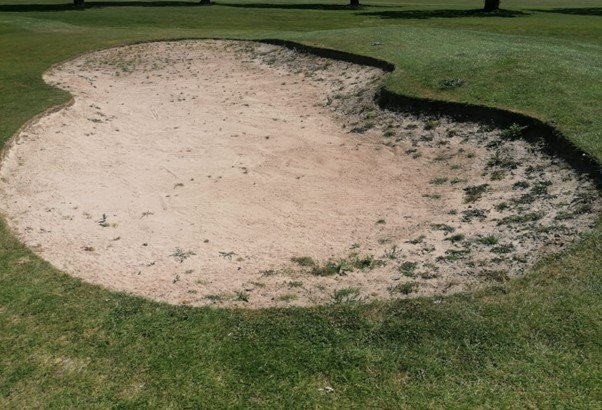December 2023 - Bunkers
One of the main talking points at PGC - and many other golf clubs - is the quality of the bunkers. 2023 has not been a good year for our bunkers, particularly regarding weeds and the quality of the sand. So, the club have listened, and the bunkers are going to receive some investment over the next few years.
The main problem we face right now is that when it rains heavily, the sand washes down the faces, bringing contamination (debris that isn’t sand) from the ground with it. Therefore, the bunker sand develops over time into a very hard pan, consisting of silts, clay, stones, and sand. This is awful to rake, hard to play out of, and makes for a poorly presented bunker.
Figure 1: Poorly presented bunker full of weeds.
At the extreme, the edges of the bunkers then have no sand in whatsoever and just become a blanket of weeds and stones. The edges have also been trimmed regularly over the years and the cumulative effect of this is that some bunkers are a lot bigger than when first developed. We will create new edges to the bunkers, reducing them in size ever so slightly (closer to the original plans), and checking all the existing drainage is working well before the liner is installed.
Figure 2: An example of one of the poorly draining bunkers, with a straight edge at the back after years of edging.
The new liner to the bunkers should prevent any future contamination of the sand, producing much more playable bunkers. We have scheduled a plan to do a few greensides each year, with the fairway bunkers in the final year. We were already planning to carry out turf repairs to greenside bunkers on the first three holes this winter.
Figure 3: A good example of a poor bunker edge on the 3rd. This will be shaped much better so that sand will remain on the face.
So, we have stripped the turf away from the edges of these bunkers, ready for creating new edges for the bunker liner to be lay over. These bunkers are now all GUR until back in play in the spring. You may see some paint lines in the bunkers during the work. This is not going to necessarily be the final line of turf, but options as we begin to plan the rebuild.
Figure 4: Paint lines in the bunker, not necessarily the final shape but plans and ideas being investigated.
On the third hole, when the course went through its slope reading assessment, the team commented that the first bunker on the left made no difference to the difficulty of the hole whatsoever and potentially could be removed. We are not going to remove it; however, we will be making it smaller, and we have started to fill in the back portion, recycling some of the old turf from the bunker edges. We will use as much recycled material as possible to keep the costs down during the project.
Figure 5: Bunker edge turf recycled to help us fill a portion of the bunker.
This liner is installed by contractors using specialist tools and they will come in once we have created the new edges for the bunkers. There are 8 bunkers to do this winter and they are confident of lining all the bunkers in the same day.
Figure 6: An example of what the liner looks when first put in.
This will take place in early February. Once the liner is installed, the turf edge is then shaped on top, soil is then added to create the final shape, followed by the final turf. The following two images are examples of the stages of the process.
Figure 7: Once liner is in, the turf edge is installed.
Figure 8: An example of a finished product with turf and sand installed.
These examples of shaping are quite extreme, we will not be looking to recreate this, only small alterations will be made.
During the time when we are working on a specific greenside bunker, we may have to close the green for safety reasons, and so a temporary green will be in place, or a full hole closure. This will be communicated at the time.
Steve
Head Greenkeeper








